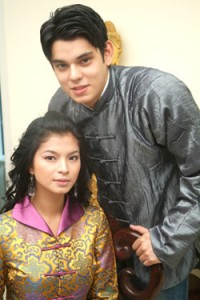Background:
Wikipedia scholars, when not watching YouPorn, speculate that our island of Luzon was once part of the Song Dynasty of China.
While the factual basis of this is still debatable, records do show that the Chinese had contact with the island of May-i (supposedly our Mindoro) centuries ago. Records also show Chinese trade with a country they called Feilubin,which was prety lazy on their part.
Since Hispanic times, the Chinese have been a permanent, if repeatedly forced into ghettoes, part of our society. There was a time, it has been written, when one could purchase a Chinese servant for 50 pesos. That was, of course, back in unenlightened times when 50 pesos was actually worth something.
The Chinese have since assimilated into our society through intermarriages and clever name changes that we don’t know where their culture ends and ours begins. Pancit with rice, though, is probably all us.
What We Call Them:
Beho- A bastardization of the Spanish viejo, for old. This doesn’t make much sense in English or Tagalog either. It may refer to old Chinese merchants who sold stuff like rhino penis, tiger balls, panda nipples and cute, furry creatures that multiply on contact with water.
Sangley-From the Hokkien word for “business,” referring, we suppose, to the merchant nature of the Chinese immigrants who came to settle here.
Sangley Point in Cavite is named after the large number of Sangleys who lived there. By that rationale, Sangley should now mean “women of negotiable virtue who provide discreet services to Navy seamen.”
Intsik- Apparently, this comes from “Indiong Tsino.” By apparently, we mean that that’s the first thing that came up on Google.
Ching-chong- An offshoot of attempts by world-recognized expert on Chinese culture Roman Tesorio Villame Ph.D’s at putting the Chinese diaspora in the Philippine context, many Filipinos now believe that mastery of the Chinese languages lies in the ability to pronounce random syllables rapidly.
Singkit– Tagalog for having slanted eyes. Because they do. Can also be substituted with pulling at the corners of your eyes, but is less rude.
Sir/Ma’am- They pretty much own us now. But in a benevolent manner, allowing us to eke out a meager living so we can play at contentment by buying their products.
What We Say About Them:
The Chinese are supposedly skinflints. This, experts say, is the secret to their wealth. That, and the cleverness to find loopholes in our labor laws, therefore allowing them to do away with things like benefits and security of tenure.
This is documented by the seminal Maynila Sa Kuko ng Liwanag and every other film from the ’70s to the ’80s that had a social message. The social message being hate the Chinese, we guess.
The Chinese also allegedly hate Filipinos and see them as “tribals.” Given how we used to buy them at 50 bucks a pop, one might say that we pretty much deserve it. Oh, and did we mention that we forced them into living in a ghetto that the Spanish shelled with their cannons every few years? How do you like them apples, Philippines? They’re from China, too. Like ponkans.
Why We’re Douchbags For Saying It:
Scratch deep enough, and almost every Filipino has Chinese blood. When history books refer to the mestizos, they meant the Chinese-Filipinos and Chinese-Spaniards who were slowly outnumbering the Spanish whose kung fu was not better than their kung fu. Full, half, one-fourth, one-eighth. Everyone is part Chinese as has been proven by Mano Po 1 through 5.
This means that when we insult the Chinese, we’re also insulting ourselves, or people we are related to, or people who know kung fu. This also means that in case the Emperor of China ever comes back to power, we’ll be 1,321,851,888th in line for the Throne of Heaven.
Also, the Chinese, along with our OFWs, are pretty much the backbone of the Philippine economy. Sure, we still have people like the Zobel de Ayalas who keep it old school by being Spanish, but every other captain of industry is Chinese, or has Chinese blood. The Lopezes are also Ongsiacos, the Gokongweis are, well, they’re Gokongweis. Name an industry, and there’s a Chinese-owned company engaged in it. We pretty much owe these guys our jobs.
If the Chinese don’t want us in their families, it’s all really just a matter of preference. Except when they’re citizens of the First World or are incredibly wealthy, we don’t want foreigners marrying into our families, either.
We have values, norms and customs that are peculiar to Filipinos, and it’s generally easier to integrate into a family that understands the culture. Unless, of course, a green card or citizenship papers is included in the dowry. In which case, it’s welcome to the family, hijo.
–OneTamad


57 Comments